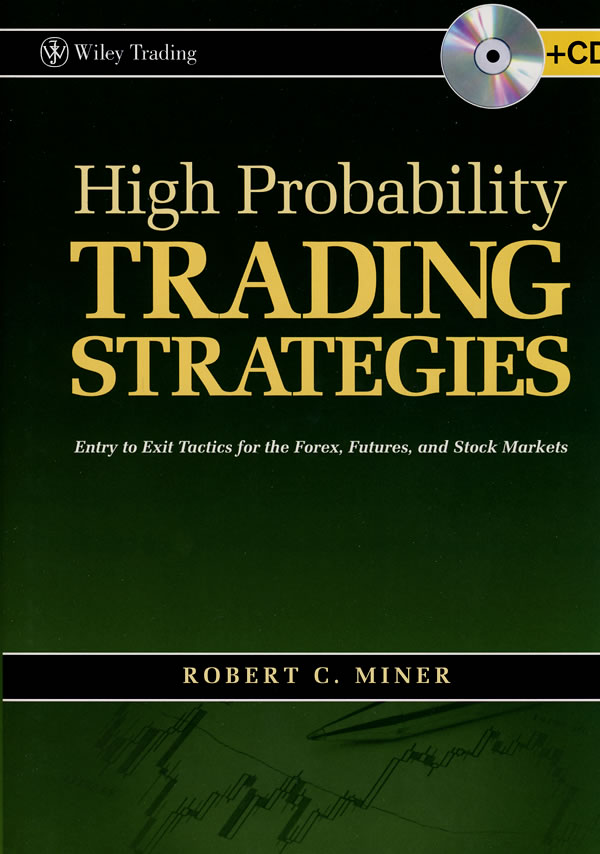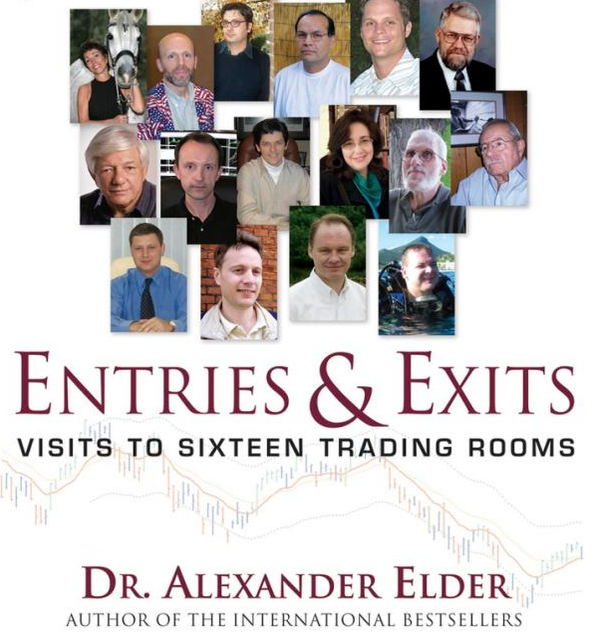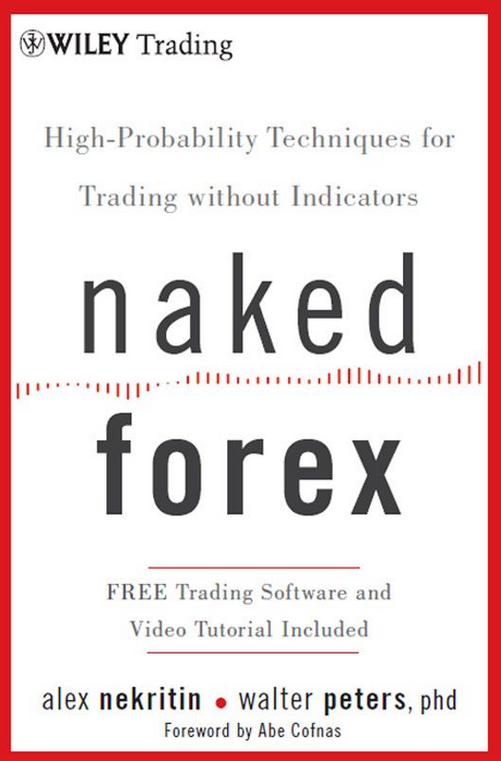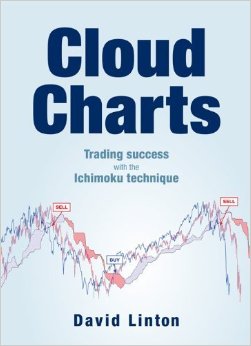Forum on trading, automated trading systems and testing trading strategies
Something Interesting to Read January 2015
newdigital, 2015.01.27 12:14
Mastering the Trade: Proven Techniques for Profiting from Intraday and Swing Trading Setups
by
John F. Carter
The bestselling Mastering the Trade presents you with a step-by-step approach for becoming a successful trader. Written with authority by fulltime trader and fund manager, John F. Carter, this straightforward, all-you-need-to-know resource combines an insightful market overview with specific trading strategies and concepts.
Forum on trading, automated trading systems and testing trading strategies
Something Interesting to Read January 2014
newdigital, 2014.01.15 07:45
High Probability Trading Strategies - Robert Miners

Trading today's markets—including stocks, futures, or Forex—can be a
challenging and difficult endeavor. But it is possible to achieve
consistent success in this field, if you're prepared to learn a complete
trading plan from entry to exit.
In High Probability Trading Strategies, author and well-known trading
educator Robert Miner skillfully outlines every aspect of a practical
trading plan—from entry to exit—that he has developed over the course of
his distinguished twenty-plus-year career. The result is a complete
approach to trading that will allow you to trade confidently in a
variety of markets and time frames.
With this book as your guide, you'll quickly learn how to recognize
high-probability trading opportunities, pinpoint exact entry and stop
prices, and manage a trade until it's completely closed out. You'll
discover how the four key factors of dual-time-frame-momentum, pattern,
price, and time can guide you down the path to trading profits. As you
become familiar with the proven strategies and techniques taught in High
Probability Trading Strategies, you'll also come to understand the type
of market information you can use to make specific trade decisions and
how to execute those decisions from start to finish.
Miner teaches in a practical, step-by-step manner until a complete
trading plan is developed. While the ideas found here are essential to
trading success, the best way to learn is by example. That's why Miner
has devoted an entire chapter—called "Real Traders, Real Time"—to trade
examples submitted by his past students. In it, you'll see how they
apply the strategies taught throughout the book to markets around the
world.
A companion website completes this comprehensive learning package. It's
not a word-for-word review of the material in the book, but rather an
additional tool to illustrate more examples. With it, you'll learn how
to put high-probability trading strategies into practice, day by day and
bar by bar, for many different markets and time frames.
Written with the serious trader in mind, High Probability Trading
Strategies details a practical approach to analyzing market behavior,
identify-ing profitable trade setups, and executing and managing
trades—from entry to exit—that will allow you to both preserve and grow
your capital. If you're looking to make the most of your time in today's
markets, look no further than High Probability Trading Strategies.
by Alexander Elder

Come behind closed doors and see real trades made by real traders.
Dr. Alexander Elder leads you into 16 trading rooms where you meet traders who open up their diaries and show you their trades.
Some of them manage money, others trade for themselves; some trade for a living, others are on the semi-professional level. All are totally serious and honest in sharing their trades with those who would like to learn.
You will meet American and international traders who trade stocks, futures, and options using a variety of methods. All are normally very private, but now, thanks to their relationships with Dr. Elder, you can see exactly how these traders decide to enter and exit trades.
Each chapter illustrates an entry and an exit for two trades, with comments by Dr. Elder.
With this book as your guide, you can get closer to mastering the key themes of trading-psychology, tactics, risk control, record keeping, and the decision-making process.
The companion Study Guide is filled with striking insights and practical advice allowing you to test your knowledge and reinforce the principles outlined in Entries & Exits.
by Alex Nekritin

Most forex traders lose because they persist in believing three myths
of successful trading:
- Myth 1: successful trading must beindicator-based.
- Myth 2: successful trading must be complex.
- Myth3: successful trading is dependent on the trading system. Well, it's time to get over these misconceptions and start winning, sayauthors Alexander Nekritin and Walter Peters in Naked Forex.
Long before computers and calculators, trading was handledwithout complex technical analysis and indicators. Trading was old school - based on using only price charts - and it was simple, profitable, and easy to implement. In Naked Forex, they show you how to successfully trade this way.
This
lively, three-part book lays out the authors' techniques indetail:
- The first part walks you through the fundamentals of forextrading and establishes the ruling tenet of all naked forextrading: price is king.
- In Part Two, the authors share methods thatlead to profits, including using resistance zones, price patterns,transitions, and such intriguing trade setups as Wammies, Moolahs,and the Last Kiss.
- In the last part of the book, you'll learn tounderstand your own trading psyche. Mastering your own attitudestoward risk, says coauthor Peters, who is also a PhD in psychology,is how you finally become a true professional trader.
Engaging and informative, this practical guide touches on many provocative topics, including:
Is it possible to outwit some of the most determined,intelligent, and well-resourced traders in the world? Find out whatit takes
The concept of "zones" and the seven most important things youneed to know about them
Six key stages you must address for every trade
Are you a runner or a gunner? When it comes to exiting a tradewith money, it's important to know
The one secret expert traders all share, why boring is good, andsix steps to becoming an expert
Why understanding yourself is paramount. What is your attitudetowards money? What are your biases? Find out how to find out
Naked trading is liberating, exhilarating, and frees you to focus on markets, instead of the indicators, say Nekritin andPeters. Follow their proprietary techniques to profitability with Naked Forex.
by Fred Piard

This book provides straightforward quantitative strategies that any investor can implement with little work using simple, free or low-cost tools and services. But what exactly is quantitative investing? There are various possible definitions of quantitative investing, but the author defines it as: "Identifying reasonable and measurable hypotheses about behaviours of the financial market so as to make investment decisions with an acceptable confidence in expected returns and risks." The main advantages in using quantitative models are that they: - make the investment process independent of opinions and emotions (the most important factor for an individual investor), and - make it reproducible by anyone at any time (the most important factor for a fund) With a set of good strategies, quantitative investing allows one to act in the market at specific pre-planned times. It is possible to work on this just once a week or month, and ignore charts and the news. It removes most of the doubts and emotions with the discipline of keeping a long-term vision and sensible money management. This book will show you how.
Forum on trading, automated trading systems and testing trading strategies
Something Interesting to Read February 2014
newdigital, 2014.02.25 16:46
Cloud Charts : Trading Successful with the Ichimoku Technique by David Linton

David Linton, the author of Cloud Charts, had his interest in Ichimoku
charts `sparked' during a presentation by Rick Bensignor at the 2004
IFTA conference in Madrid. David had heard of the method prior to the
conference but credits Rick with presenting it in an `understable' way.
David set out on a quest for Ichimoku knowledge. He researched the
internet, questioned Japanese delegates at subsequent IFTA conferences,
sought out Rick Bensignor at conferences and meetings and even flew to
Tokyo. The fruit of that quest is the book, Cloud Charts.
The Ichimoku method is now fast becoming popular in Western trading
rooms and is available on almost all technical analysis software. David
must take some credit for turning what seemed to be an exotic and
complicated method into an easily understandable and robust trading and
analysis tool for non-Japanese speaking technical analysts.
So, what is Ichimoku? The full name of the method is Ichimoku Kinko Hyo
which means 'at one glance balance bar chart'. Ichimoku charts were
devised by Goichi Hosoda , a Tokyo journalist, who believed that once
the method was fully understood, one could comprehend the exact state of
a market at a glance. Most of the Ichimoku indicators represent
equilibrium in one time frame or another and price action is generally
analysed with regard to whether the market is in equilibrium, moving
away from it or reverting back to it. By their nature, the various
indicators also offer dynamic areas of support or resistance.
Cloud Charts is divided into three parts. The first is for the novice
technical analyst and is designed to give them an understanding of many
basic technical analysis concepts involved with not only Ichimoku
analysis but also traditional techniques. More experienced technical
analysts may wish to skip this part.
Part two introduces the reader to the basic indicators used in Ichimoku
charts (David calls them cloud charts). This section deals with the
derivation and interpretation of:
1. The Turning Line (also called the Conversion Line)
2. The Standard Line ( also called the Base Line)
3. The Cloud Span A ( also called the Cloud Span 1)
4. The Cloud Span B (also called the Cloud Span 2)
5. The Lagging Line ( also called the Lagging Span)
Part two offers a guide to applying Ichimoku charts in a multiple time
frame sense, as well as the often overlooked Wave Principle, Price
Targets and Time Span Principle. However, the application of Ichimoku
charts to price and time projection is very subjective and for that
reason alone the projections are quite often not utilised by even
experienced analysts.
Looking at an Ichimoku chart, it's no surprise that analysts are
sometimes turned off by the busyness of the chart. It can look like
chaos to the uninitiated but the key to getting past that is
understanding the formula to each indicator, how they combine with each
other, how they represent a consensus of price action in different time
frames and colour-coding. In part two David explains construction and
interpretation of the charts in a manner that is easy for any newcomer
to technical analysis let alone a professional on a trading desk.
Part three, is where we are encouraged to think outside of the box.
Here, the use of Ichimoku charts are combined with other technical
analysis techniques, alternative time inputs into the indicators are
suggested and the application to market breadth analysis is considered.
There is also a chapter on back testing for the quantitative traders to
consume.
Overall, this book, in an easily read manner, brings together the body
of knowledge of a Japanese technical analysis method which was once
thought of as exotic and over-complicated. It has potential to become
the definitive English language text on the Ichimoku Kinko Hyo technical
analysis method.
- Free trading apps
- Over 8,000 signals for copying
- Economic news for exploring financial markets
You agree to website policy and terms of use

This is the thread about books related for stocks, forex, financial market and economics. Please make a post about books with possible cover image, short description and official link to buy (amazon for example).
Posts without books' presentation, without official link to buy and with refferal links will be deleted.Posts with links to unofficial resellers will be deleted